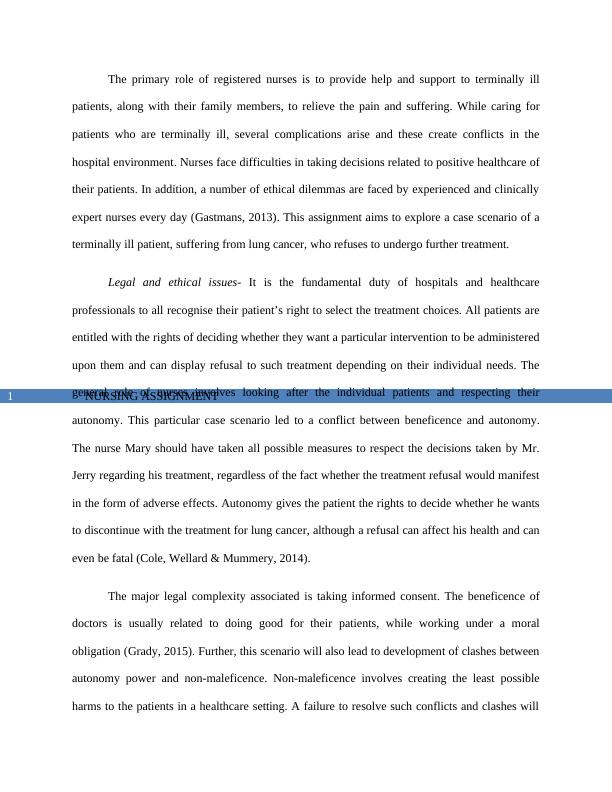Ask a question from expert
Ethical and Legal challenges- A Case Study
7 Pages1480 Words81 Views
Added on 2020-04-21
Ethical and Legal challenges- A Case Study
Added on 2020-04-21
BookmarkShareRelated Documents
Running head: NURSING ASSIGNMENTEthical and Legal challenges- A Case Study scenarioName of the StudentName of the UniversityAuthor Note

NURSING ASSIGNMENT1The primary role of registered nurses is to provide help and support to terminally illpatients, along with their family members, to relieve the pain and suffering. While caring forpatients who are terminally ill, several complications arise and these create conflicts in thehospital environment. Nurses face difficulties in taking decisions related to positive healthcare oftheir patients. In addition, a number of ethical dilemmas are faced by experienced and clinicallyexpert nurses every day (Gastmans, 2013). This assignment aims to explore a case scenario of aterminally ill patient, suffering from lung cancer, who refuses to undergo further treatment.Legal and ethical issues- It is the fundamental duty of hospitals and healthcareprofessionals to all recognise their patient’s right to select the treatment choices. All patients areentitled with the rights of deciding whether they want a particular intervention to be administeredupon them and can display refusal to such treatment depending on their individual needs. Thegeneral role of nurses involves looking after the individual patients and respecting theirautonomy. This particular case scenario led to a conflict between beneficence and autonomy.The nurse Mary should have taken all possible measures to respect the decisions taken by Mr.Jerry regarding his treatment, regardless of the fact whether the treatment refusal would manifestin the form of adverse effects. Autonomy gives the patient the rights to decide whether he wantsto discontinue with the treatment for lung cancer, although a refusal can affect his health and caneven be fatal (Cole, Wellard & Mummery, 2014). The major legal complexity associated is taking informed consent. The beneficence ofdoctors is usually related to doing good for their patients, while working under a moralobligation (Grady, 2015). Further, this scenario will also lead to development of clashes betweenautonomy power and non-maleficence. Non-maleficence involves creating the least possibleharms to the patients in a healthcare setting. A failure to resolve such conflicts and clashes will

NURSING ASSIGNMENT2create a sense of mistrust in the patient for the nurse. Any violation of the autonomy of decisionmaking rights of the patient will affect the nurse-client relationship (Ivanov & Oden, 2013). Proper steps should be enforced by the hospital administration to inform Mr. Jerry’sdaughter of his thoughts that he will become a burden on her if he continues the treatment, andshe will face difficulties in managing her household (Preshaw et al., 2016). According to theUniversal Declaration of Human Rights, all patients have the right to decide whether they wantto continue with a particular treatment in a hospital. Thus, care should be taken to ensure that thepatient rights are safeguarded and not violated (Who.int, 2017). Ethical decision making process- The values of the SNB code of ethics mention thepractices that should be followed by nurses and midwives in a healthcare setting. All nurses mustprovide such care that prevents nurses from discriminating between patients on the basis ofgender, ethnicity, religion, age, and social and economic status. Moreover, the nurse Maryshould follow the standards of practice that emphasize on the duty to help patients in talkingabout their individual needs, through effective conversation The standard codes of practicedirects the nurses to modify the healthcare delivery plans depending on specific client needs(Healthypeople.gov, 2017). In addition, the second value statement instructs the nurses to protect and safeguard theautonomy of their patients, which will eventually provide the latter with a discretionary power todecide for the continuation of a particular treatment plan. The nurses should also provide accessto all available information to their patients, to help them understand the efficacy of the proposedintervention (Healthypeople.gov, 2017). In addition, efficient workplace collaboration within theorganisation culture is essential to deliver optimal health outcomes to the patients (Slegers et al.,

End of preview
Want to access all the pages? Upload your documents or become a member.
Related Documents
Nursing Assignment Ethical and Legal Challengeslg...
|6
|1463
|278
UNCC100 - Self and Community Assignmentlg...
|5
|1100
|274
Legal and Ethical Decision Making in End-of-Life Carelg...
|7
|1450
|359
A Scenario Involving a Terminally Ill Patientlg...
|3
|591
|14
Health Ethics - End of Life Treatmentslg...
|9
|1372
|36
Collaborative Ethical Decision Making | Essaylg...
|9
|2180
|19